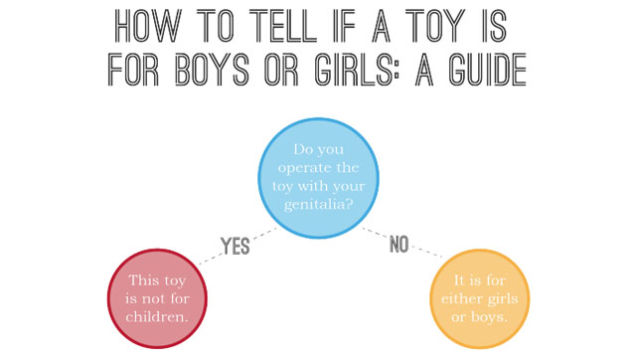This is one of my favourite flow charts:

Image by Kristen Myers Design/Paranoid Shiksa Feminista.
In case you can’t see that, it says: “How to tell if a toy is for boys or girls: a guide. Do you operate the toy with your genitalia? If yes, this toy is not for children. If no, this toy is for either girls or boys”.
Hilarious right? If only more people knew and accepted that though.
Alas right now, there’s a massive amount of toy gendering. I was going to say “pointless gendering”, but actually, no, it’s harmful gendering.
Take a look at these books:
@WHSmith @LetToysBeToys amazing as I thought they were just books. pic.twitter.com/hJFxXykwjJ
— D Hall (@DBH1954) April 27, 2015What’s the message there? That dinosaurs and pirates and trucks and tools are “for boys”, while fairies and flowers and castles are “for girls”. Bollocks.
“But Kristian”, I hear you say (well actually I don’t, but it’s a convenient rhetorical trick to imagine that you do), “But Kristian, these are just a few books, a few toys, a bit of branding here and there; surely it’s not that much of a problem?”
Every single pack of this “Boy Zone” (nothing to do with the band) bedding containing sheets covered in dinosaurs is another message to a little girl who loves T-Rexes that maybe dinosaurs aren’t for her. Every “girl’s toy” that’s just a regular toy coloured pink, tells a little boy whose favourite colour is best described as fuchsia that maybe he’s weird for liking that colour.
I don’t have any children that I shop for, and as a child my interests fell within (tedious and patriarchal) standard stereotypes, so I managed to be blind to all of this for quite some time. Then I came across the excellent Let Toys Be Toys campaign on Twitter a few years back and saw just how wide-spread the problem was.
Follow them on Twitter. Send them pictures of gendered toys. Support them in convincing retailers and manufacturers to fix their branding. Help children grow up in a world where gender doesn’t define their interests. Let toys be toys.